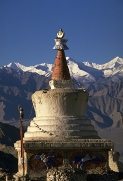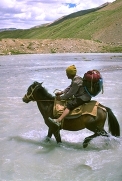|
|
 |
TECTONIC AND METAMORPHIC EVOLUTION
OF THE CENTRAL HIMALAYAN DOMAIN
IN SOUTHEAST ZANSKAR
by Pierre Dèzes
|
 |
| |
2. GEOLOGICAL OVERVIEW
Shiva is deep in meditation in an ice-locked cave in the Himalayas. The goddess who loves him has been banished from his sight lest she disturb his meditation. She wanders the world trying to forget the great ascetic, determined not to look in his direction. But she cannot help herself and standing on a wave in the middle of the Indian Ocean, she turns and stretches her arms towards the mountains, beseeching the ascetic god to enter her embrace. Into the space between her arms explode rice fields and deserts and stone fortresses and elephants and glaciers and coconut palms and temples - in short the continent of India. This is why India is shaped in the semaphore of embrace
«Ladders and Snakes» Gita Mehta
|
|
|
2.1 Introduction
Among the most dramatic and visible creations of plate tectonic forces are the lofty Himalayas, which stretch over 2900 km along the border between India and Tibet. This immense mountain range was formed by huge tectonic forces and sculpted by powerful denudation processes. The Himalaya-Tibet region is virtually the water tower of Asia: it supplies freshwater for more than one-fifth of the world population, and it accounts for a quarter of the global sedimentation budget. Topographically, the belt has many superlatives: the highest rate of uplift (nearly 1 cm/year at Nanga Parbat), the highest relief (8848 m at Mt. Everest Chomolangma), the source of some of the greatest rivers and the highest concentration of glaciers outside of the polar regions. This last feature earned the Himalaya its name meaning in Sanskrit: «the abode of the snow».
|
|
|
previous page: Chapter1 |
next page "The making of the Himalaya" |
 |
©Pierre Dèzes
|